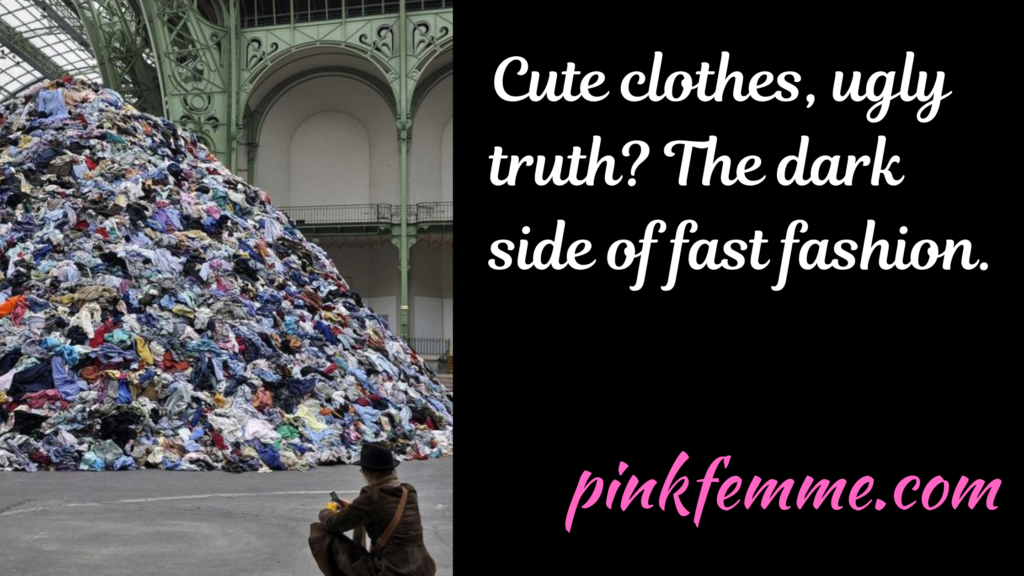
I have always done my best to maintain a small wardrobe of elegant garments that fit me well and are timeless in design so that they can be worn for multiple seasons. However, I won’t lie to you and say that I’m not a victim of affordable fast fashion. There have been many occasions when I have needed a dress/outfit for a specific occasion and I’ve rushed off to a fast fashion outlet at the last moment to find something that will work.
Fast fashion consists of garments that are produced very quickly to keep up with the ever-changing fashion trends. Garments are produced and sold cheaply so that they don’t last longer than a single season. These garments are made from synthetic fabrics leading to massive waste/pollution.
Let’s look more closely at the world of fast fashion so that even if we do purchase these kinds of garments, we can make informed purchasing decisions and minimize our impact on the environment around us.
Introduction to Fast Fashion
Fast fashion has become a dominant force in the fashion industry, revolutionizing the way we consume clothing. Defined by its quick turnover of trends and affordable prices, fast fashion has gained popularity among consumers worldwide.
Fast fashion refers to the rapid production and distribution of inexpensive clothing that is inspired by the latest runway trends. It is characterized by its ability to quickly respond to changing fashion trends and deliver new styles to the market at an accelerated pace. This allows consumers to stay up-to-date with the latest fashion trends without breaking the bank.

The prevalence of fast fashion can be attributed to its affordability and accessibility. With the rise of global supply chains and advancements in technology, fast fashion brands are able to produce large quantities of clothing at low costs. This enables them to offer trendy and affordable clothing options to a wide range of consumers.
However, the fast fashion industry has faced criticism for its negative impact on the environment and labor practices. The rapid production and disposal of clothing contribute to excessive waste and pollution, while the exploitation of workers in low-wage countries is a major concern.
In the following sections, we will delve deeper into the various aspects of fast fashion, including its impact on the environment, labor practices, and the rise of disposable culture. We will also explore alternatives to fast fashion and the efforts being made to create a more sustainable and responsible fashion industry.
The Rapid Cycle of Trends
Fast fashion operates on a rapid cycle of trends, constantly churning out new styles and designs to keep up with consumer demand. This fast-paced approach to fashion has a significant impact on both consumer behavior and the environment.
One of the key aspects of fast fashion is its ability to quickly respond to changing trends. Fashion trends come and go at a rapid pace, and fast fashion brands are able to capitalize on this by producing and delivering new styles to the market in a matter of weeks. This constant influx of new trends creates a sense of urgency among consumers to stay up-to-date with the latest fashion, leading to frequent purchases and a cycle of constant consumption.

This rapid cycle of trends has a profound effect on consumer behavior. With new styles constantly being introduced, consumers are encouraged to buy more and buy more often. The affordability of fast fashion makes it easy for consumers to indulge in impulse purchases, leading to a culture of disposable fashion. Consumers are more likely to discard clothing after only a few wears, contributing to the growing problem of textile waste.
Furthermore, the rapid turnover of trends in fast fashion has a significant environmental impact. The production of new clothing requires the use of valuable resources such as water, energy, and raw materials. Additionally, the disposal of unwanted clothing contributes to landfill waste and pollution. The fast fashion industry is notorious for its contribution to environmental degradation, making it a subject of concern for sustainability advocates.
In the next section, we will delve deeper into the labor practices associated with fast fashion and the ethical concerns surrounding the industry. We will explore the low wages and poor working conditions faced by garment workers, shedding light on the human cost of fast fashion. Additionally, we will discuss the efforts being made to address these issues and promote fair labor practices in the fashion industry.
Labor Practices in Fast Fashion
Fast fashion has long been criticized for its controversial labor practices, which encompass a range of issues including low wages, poor working conditions, and ethical concerns. One of the main criticisms leveled against the industry is the exploitation of garment workers in developing countries. Many fast fashion brands outsource their production to countries with lax labor laws and regulations, allowing them to take advantage of cheap labor.
Low wages are a pervasive issue in the fast fashion industry. Garment workers often earn meager salaries that are barely enough to cover their basic needs. This perpetuates a cycle of poverty and inequality, trapping workers in a system that offers little opportunity for upward mobility. Moreover, the pressure to meet tight production deadlines and deliver products at low costs often leads to excessive overtime and unpaid work.

Poor working conditions are another major concern. Many garment factories lack proper safety measures, exposing workers to hazardous environments. Long working hours, lack of breaks, and inadequate access to healthcare are common issues faced by these workers. Additionally, the prevalence of subcontracting and informal labor practices further exacerbates the vulnerability of workers, making it difficult to hold brands accountable for labor violations.
Ethical concerns also arise from the use of child labor and forced labor in the fast fashion supply chain. Despite international labor standards and regulations, instances of child labor and forced labor continue to be reported in the industry. This raises serious ethical questions about the responsibility of brands to ensure fair and ethical practices throughout their supply chains.
In the next section, we will explore the environmental impact of fast fashion, shedding light on the waste generation, resource depletion, and carbon footprint associated with the production and disposal of clothing. We will delve into the urgent need for sustainable alternatives and responsible practices in the fashion industry.
Environmental Impact
The environmental impact of fast fashion is significant and far-reaching. One of the key consequences is the generation of massive amounts of waste. Fast fashion encourages a culture of disposability, where clothing items are quickly discarded and replaced with new ones. This leads to overflowing landfills and contributes to the growing problem of textile waste. Additionally, the production of fast fashion garments requires a significant amount of resources, leading to resource depletion. The extraction of raw materials, such as cotton and petroleum-based synthetic fibers, puts a strain on natural resources and contributes to environmental degradation.
Another major environmental concern is the carbon footprint associated with the production and disposal of clothing. The fast fashion industry relies heavily on transportation, both for sourcing materials and distributing finished products. This results in high levels of greenhouse gas emissions, contributing to climate change. Furthermore, the disposal of clothing items often involves incineration or landfilling, both of which release harmful pollutants into the environment.

To address these environmental issues, sustainable alternatives, and responsible practices are crucial. This includes embracing circular economy models, where clothing is designed to be recycled or upcycled, reducing the need for new production. It also involves promoting eco-friendly materials and production processes, such as organic and recycled fabrics, and implementing proper waste management systems. By adopting these practices, the fashion industry can minimize its environmental impact and work towards a more sustainable future.
Disposable Culture: The Rise of Throwaway Fashion
The rise of fast fashion has brought about a significant shift towards a disposable culture in the fashion industry. This disposable culture refers to the mentality of treating clothing items as short-term, disposable goods rather than long-lasting investments. This shift is fueled by several factors, including the constant influx of new trends, the affordability of fast fashion garments, and the influence of social media.
One of the main consequences of this disposable culture is the short lifespan of clothing items in fast fashion. With trends changing at a rapid pace, consumers are encouraged to constantly update their wardrobes to stay in style. As a result, clothing items are worn only a few times before being discarded and replaced with new ones. This cycle of consumption leads to a significant increase in textile waste and contributes to the environmental impact of the fashion industry.
Moreover, the affordability of fast fashion plays a crucial role in promoting this disposable culture. With low prices, consumers are more inclined to view clothing as disposable commodities rather than long-term investments. This mindset encourages impulse buying and a lack of attachment to clothing items, further perpetuating the cycle of disposability.
The influence of social media also contributes to the rise of throwaway fashion. Platforms like Instagram and TikTok constantly showcase new trends and styles, creating a sense of urgency to keep up with the latest fashion. This pressure to constantly update one’s wardrobe fuels the disposable culture and reinforces the idea that clothing is disposable and easily replaceable.
In order to address the issue of throwaway fashion, it is important to promote a shift towards more sustainable and responsible consumption habits. This includes investing in high-quality, timeless pieces, embracing second-hand and vintage clothing, and supporting brands that prioritize ethical and sustainable practices. By challenging the disposable culture and making conscious choices, consumers can contribute to a more sustainable and responsible fashion industry.
Social and Cultural Implications
Fast fashion has not only transformed the fashion industry but also had significant social and cultural implications. One of the key aspects is its influence on individual identities. With the constant influx of new trends, fast fashion encourages individuals to constantly update their wardrobes to stay in style. This pressure to conform to the latest fashion can lead to a loss of individuality as people strive to fit into the mold of what is considered fashionable.
Moreover, fast fashion has also played a role in shaping body image ideals. The industry promotes a narrow and unrealistic standard of beauty, often showcasing thin models with unattainable body proportions. This can have detrimental effects on individuals’ self-esteem and body image, as they may feel pressured to conform to these ideals.
Another cultural implication of fast fashion is the perception of value in clothing. With the affordability of fast fashion garments, there is a shift towards viewing clothing as disposable commodities rather than long-term investments. This can lead to a devaluation of clothing and a lack of appreciation for the craftsmanship and quality that goes into creating garments.

To address these social and cultural implications, it is important to promote diversity and inclusivity in the fashion industry. This includes featuring a range of body types and promoting a more realistic and inclusive standard of beauty. Additionally, educating consumers about the true cost of fast fashion and the importance of valuing clothing as long-term investments can help shift the perception of value. By fostering a more inclusive and conscious fashion culture, we can create a positive impact on society and individuals’ well-being.
Alternatives to Fast Fashion
Sustainable and ethical alternatives to fast fashion are gaining momentum as consumers become more conscious of the environmental and social impact of their clothing choices. One such alternative is the rise of slow fashion, which emphasizes quality over quantity and encourages consumers to invest in timeless, well-made pieces that will last for years. Slow fashion brands prioritize fair wages and safe working conditions for their workers, as well as sustainable production practices.
Another alternative is the second-hand market, which includes thrift stores, consignment shops, and online platforms for buying and selling pre-owned clothing. Buying second-hand not only reduces waste but also allows consumers to find unique and affordable pieces. Additionally, clothing rental services have emerged as a popular alternative, allowing individuals to rent clothing for special occasions or everyday wear, reducing the need for constant purchasing.
Furthermore, there are brands that focus on using sustainable materials, such as organic cotton, hemp, and recycled fabrics. These brands prioritize transparency in their supply chains and often support local artisans and communities. Some brands also offer repair and recycling programs to extend the lifespan of their garments and reduce waste.
To promote responsible consumption, consumers can practice mindful shopping by considering the longevity and versatility of a garment before making a purchase. They can also support local and independent designers who prioritize sustainability and ethical practices. Educating oneself about the impact of fast fashion and sharing this knowledge with others can also contribute to creating a more sustainable and ethical fashion industry.
By embracing these alternatives and making conscious choices, consumers can play a significant role in driving positive change in the fashion industry, promoting sustainability, and supporting ethical practices.
Consumer Awareness and Education
Consumer awareness plays a crucial role in addressing the controversies surrounding fast fashion. By educating themselves about the negative impacts of the industry, consumers can make more informed choices and contribute to positive change.
One way to educate and empower consumers is through increased transparency in the fashion supply chain. Brands can provide information about their sourcing practices, production methods, and labor conditions. This transparency allows consumers to make ethical and sustainable choices by supporting brands that prioritize fair wages, safe working conditions, and environmentally friendly production processes.

Another way to promote consumer awareness is through media campaigns and educational initiatives. Fashion documentaries, articles, and social media campaigns can raise awareness about the social and environmental consequences of fast fashion. These initiatives can highlight the importance of sustainable and ethical alternatives, as well as the power of individual consumer choices.
Additionally, educational programs in schools and communities can teach young people about the impact of their clothing choices. By integrating sustainability and ethics into the curriculum, students can develop a critical understanding of the fashion industry and become conscious consumers from an early age.
Consumer advocacy groups and non-profit organizations also play a vital role in raising awareness and providing resources for consumers. These organizations can offer information on sustainable brands, ethical shopping guides, and tips for extending the lifespan of clothing through repair and upcycling.
By increasing consumer awareness and providing education, individuals can make more conscious choices when it comes to fashion. Empowered consumers have the potential to drive demand for sustainable and ethical practices, encouraging the industry to change and become more responsible.
Regulatory Efforts and Industry Changes
Current regulations and industry initiatives are being implemented to address the negative impact of fast fashion and promote more sustainable practices. One key regulatory effort is the implementation of stricter labor laws and regulations to protect the rights of garment workers. This includes ensuring fair wages, safe working conditions, and the prohibition of child labor. These regulations aim to hold brands accountable for their supply chain practices and promote ethical labor practices.
Another important industry change is the adoption of sustainable and eco-friendly production methods. Many fashion brands are now incorporating sustainable materials, such as organic cotton and recycled fabrics, into their collections. Additionally, there is a growing trend towards circular fashion, which focuses on reducing waste and promoting recycling and upcycling of clothing.

Furthermore, industry initiatives are being launched to encourage transparency and traceability in the fashion supply chain. This includes the use of blockchain technology to track the journey of garments from production to sale. By providing consumers with information about the origins of their clothing, these initiatives empower them to make more informed choices.
While these regulatory efforts and industry changes are steps in the right direction, their effectiveness is still being evaluated. It is important to continue monitoring and assessing their impact on labor practices, environmental sustainability, and consumer behavior. By continuously improving regulations and industry practices, we can work towards a more responsible and sustainable fashion industry.
Fashion Revolution and Activism
Fashion activism plays a crucial role in advocating for transparency, ethical practices, and systemic change within the fashion industry. Movements like Fashion Revolution have emerged to challenge the status quo and demand greater accountability from fashion brands.
Fashion Revolution, founded in response to the Rana Plaza factory collapse in 2013, aims to raise awareness about the social and environmental impacts of fast fashion. Through campaigns like “Who Made My Clothes?” and “Fashion Revolution Week,” they encourage consumers to question the origins of their clothing and demand transparency from brands.

One of the key objectives of fashion activism is to promote ethical practices throughout the supply chain. Activists push for fair wages, safe working conditions, and the elimination of exploitative labor practices. By shining a light on the dark side of the industry, they strive to create a more equitable and sustainable fashion system.
Fashion activism also seeks to challenge the throwaway culture perpetuated by fast fashion. It promotes the idea of conscious consumption, encouraging individuals to buy less and choose quality over quantity. By advocating for sustainable alternatives like second-hand shopping, upcycling, and clothing rental services, activists aim to reduce the environmental impact of the fashion industry.
Through their collective efforts, fashion activists are pushing for systemic change within the industry. They collaborate with brands, policymakers, and consumers to drive innovation and create a more responsible fashion future. By amplifying their voices and supporting their initiatives, we can all contribute to a more ethical and sustainable fashion industry.
Case Studies: Notable Fast Fashion Controversies
Fast fashion has been at the center of numerous controversies that have sparked public concern and shed light on the dark side of the industry. These case studies serve as real-world examples of the social and environmental impacts of fast fashion.
One notable controversy is the 2013 Rana Plaza factory collapse in Bangladesh, which resulted in the death of over 1,100 garment workers. This tragedy exposed the dangerous working conditions and lack of safety regulations in the fast fashion supply chain. It prompted widespread outrage and calls for greater accountability from fashion brands.

Another case study is the use of toxic chemicals in textile production. Many fast fashion brands have been criticized for using hazardous substances that pose risks to both workers and consumers. For example, the use of azo dyes, which can release carcinogenic substances, has raised concerns about the health effects of wearing fast fashion garments.
Additionally, the issue of cultural appropriation has been a subject of controversy in the fast fashion industry. Brands have faced backlash for appropriating traditional designs and motifs without giving credit or compensation to the communities they originate from. This raises questions about the ethics of profiting from cultural heritage without respecting its significance.
These case studies highlight the urgent need for change within the fast fashion industry. They demonstrate the importance of transparency, ethical practices, and consumer awareness in addressing the controversies surrounding fast fashion. By examining these real-world examples, we can better understand the impact of our fashion choices and work towards a more sustainable and responsible fashion future.
The Future of Fashion: Sustainable and Responsible Practices
The future of the fashion industry lies in embracing sustainable and responsible practices. As consumers become more aware of the social and environmental impacts of fast fashion, there is a growing demand for ethical and environmentally friendly alternatives. Fashion brands are starting to recognize the need for change and are taking steps towards a more sustainable future.
One key aspect of the future of fashion is the shift towards circularity. This involves designing garments with the intention of extending their lifespan and minimizing waste. Brands are exploring innovative ways to recycle and upcycle materials, reducing the reliance on virgin resources. By implementing closed-loop systems, fashion companies can create a more sustainable and circular economy.
Another important aspect is transparency and traceability. Consumers are increasingly interested in knowing where their clothes come from and how they are made. Brands that prioritize transparency and provide information about their supply chains and production processes are gaining trust and loyalty from consumers. This transparency also allows for greater accountability and ensures that workers are treated fairly throughout the supply chain.
Furthermore, technology is playing a significant role in shaping the future of fashion. From 3D printing to virtual reality, advancements in technology are revolutionizing the way garments are designed, produced, and consumed. These innovations have the potential to reduce waste, improve efficiency, and create more personalized and sustainable fashion experiences.
In conclusion, the future of fashion lies in sustainable and responsible practices. By embracing circularity, transparency, and technological advancements, the industry can move towards a more ethical and environmentally friendly approach. Consumers have the power to drive this change by making conscious choices and supporting brands that prioritize sustainability. Together, we can create a fashion industry that is both stylish and sustainable.
Why not expand your style and fashion knowledge even further by reading another style/fashion article here on Pink Femme? You can find them either via the menu at the top of the page or by clicking this link that will take you to the list of all my style and fashion articles.
